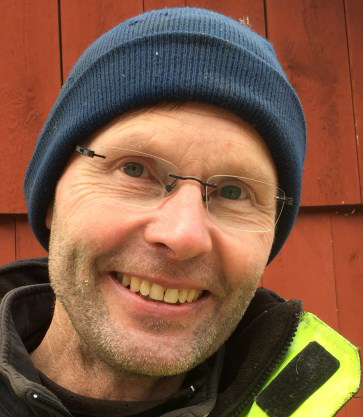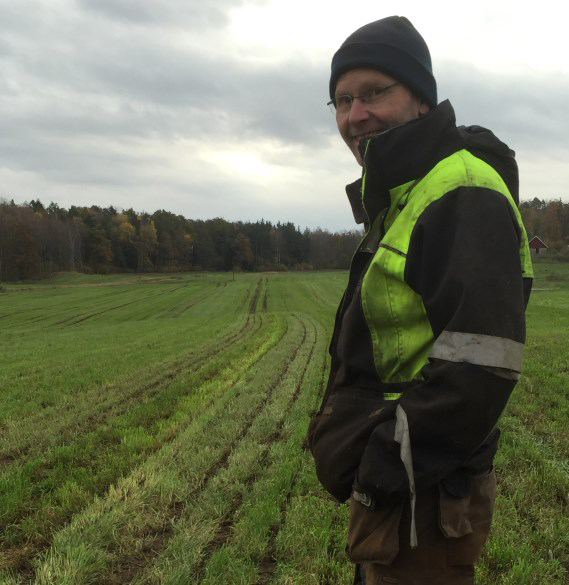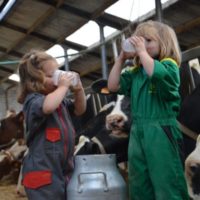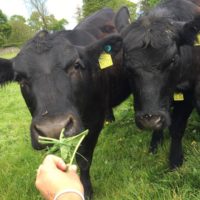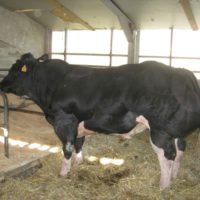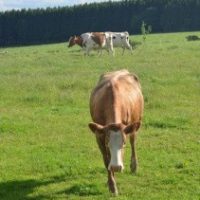Cocksfoot as a marker for CTF
Börje Persson, Humlaröd
 Cocksfoot as a marker for CTF (.pdf)
Cocksfoot as a marker for CTF (.pdf)
 Hundäxing markerar fasta körspår (.pdf)
Hundäxing markerar fasta körspår (.pdf)
Description
Cheap and effective tramline markers save time and spare the ley
In the past, half the time spent on fertilising the ley went on marking tramlines to avoid overlaps, but Börje found an envi-ronmentally friendly solution in the 1980s, long before GPS-systems were on the market. His first attempt was an unsown row in the ley, while the current system is a row sown with cocksfoot to make a biological tramline marker. This leads to time saved when spreading fertiliser and slurry. It also saves time as there is less need for instructing drivers on how to cover irregular fields, since the cocksfoot marker shows the most effective path. The improvement also leads to increased yield, an extra harvest every ten years according to Danish trials. The present goal is to adapt the ley harvesting machinery to the same width.
The cocksfoot tramline marker is very simple, but effective. It is also much less expensive than modern GPS equipment available. It always remains in the next year. The farm keeps an old seed drill exclusively for ley sowing. It is equipped with a separate slot for the cocksfoot seed and has modified coulters for sowing no deeper than 2 cm. This is only one of several technical solutions on the farm evolved from a devoted interest.
Reason for the innovation
Saving time and less soil compaction, thanks to curiosity about technical solutions
The first method was simply to plug one of the coulters on the seed drill, but the unsown strip filled with weeds. Cocksfoot was a better solution. It appears clearly prior to timothy and ryegrass thanks to faster development in all cuts. A separate compart-ment for cocksfoot seed in the seed drill makes the system work.
Farm description
Environment
- Soil types: Loam, sand and peat soils
- Climate: Temperate continental climate
- Altitude: 65 m a.s.l
- Slope: 0 %
- The farm is situated in Skåne, southern Sweden.
Grassland management
- Grazing: Yes
- Temporary grassland based on red clover, white clover, timothy, perennial ryegrass and tall fescue.
Structure
- Annual Work Unit: 4
- 160 ha arable land area, of which
- 65 ha temporary grassland area for cutting
- 5 ha temporary grassland area for grazing
- 29 ha semi-natural grassland area.
- Winter wheat, faba beans, triticale and barley are grown.
Animal performance
- 140 dairy cows (Holstein), producing 9,500 kg milk per year in VMS.
Why it is working
Anyone can try this, also in small fields, as long as the ley is composed of species with slower development than cocksfoot. However, adjusting all machinery to the same width is challenging. The width of the seed drill needs to be compatible with today’s large harvesting machinery. On this farm, a 6-m Tive seed drill is used solely for ley sowing.
Additional information
| Farming system | organic farming |
|---|---|
| Domains of innovation | forage mixture, machinery, tools |
| Main types of animal | dairy cattle |
| Country | Sweden |
| Product type | Farmer portrait |
| Language | English, Swedish |
